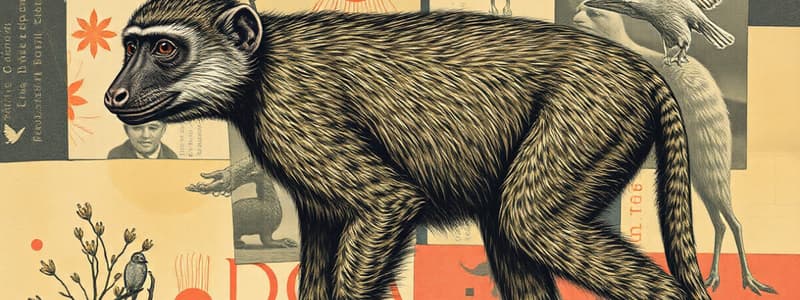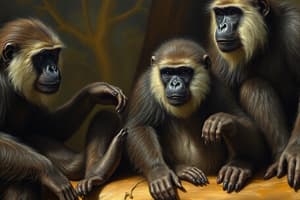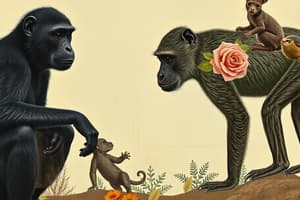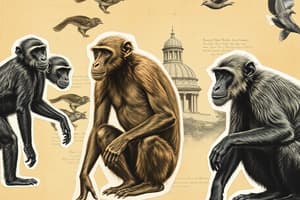Podcast
Questions and Answers
Which of the following traits is LEAST likely to be observed across all mammal species?
Which of the following traits is LEAST likely to be observed across all mammal species?
- Production of mother's milk for offspring nourishment.
- Extended period of dependence of offspring on parents.
- Complex social structures learned through play. (correct)
- Giving birth to live young instead of laying eggs.
How does the arboreal quadruped's scapula placement uniquely aid in its locomotion?
How does the arboreal quadruped's scapula placement uniquely aid in its locomotion?
- The laterally placed scapula enhances arm movement range for brachiation. (correct)
- The ventrally placed scapula stabilizes the body during leaping.
- The dorsally placed scapula increases stride length on the ground.
- The medially placed scapula improves balance on narrow branches.
Suppose scientists discover a new primate species with a highly developed sense of smell and mobile ears. Based on this information, to which primate suborder would this species most likely belong?
Suppose scientists discover a new primate species with a highly developed sense of smell and mobile ears. Based on this information, to which primate suborder would this species most likely belong?
- Catarrhini.
- Haplorrhini.
- Strepsirrhini. (correct)
- Platyrrhini.
Which of the following is the MOST significant implication of primates having forward-facing eyes and stereoscopic vision?
Which of the following is the MOST significant implication of primates having forward-facing eyes and stereoscopic vision?
If a primate species exhibits female dominance within its social structure, is NOT sexually dimorphic, and primarily consumes vegetation and insects, which of the following groups does it MOST likely belong to?
If a primate species exhibits female dominance within its social structure, is NOT sexually dimorphic, and primarily consumes vegetation and insects, which of the following groups does it MOST likely belong to?
How does the dental formula of Platyrrhines differ significantly from that of Catarrhines, reflecting their evolutionary divergence and dietary adaptations?
How does the dental formula of Platyrrhines differ significantly from that of Catarrhines, reflecting their evolutionary divergence and dietary adaptations?
Which of the following traits would be LEAST expected in species of the Hylobates genus, considering their adaptation to brachiation?
Which of the following traits would be LEAST expected in species of the Hylobates genus, considering their adaptation to brachiation?
How does the typical social structure of gorillas (Pongids) differ from that of bonobos and chimpanzees, influencing group dynamics and individual behavior?
How does the typical social structure of gorillas (Pongids) differ from that of bonobos and chimpanzees, influencing group dynamics and individual behavior?
Considering primate adaptations related to body size and activity patterns, which of the following scenarios would MOST likely favor the evolution of a larger body size and diurnal activity in a primate species?
Considering primate adaptations related to body size and activity patterns, which of the following scenarios would MOST likely favor the evolution of a larger body size and diurnal activity in a primate species?
How does the use of tools by chimpanzees inform our understanding of cultural transmission and cognitive complexity in hominins?
How does the use of tools by chimpanzees inform our understanding of cultural transmission and cognitive complexity in hominins?
Which of the following best explains the distinction between homologous and analogous traits, as it applies to primate evolution?
Which of the following best explains the distinction between homologous and analogous traits, as it applies to primate evolution?
Which of the following is the MOST critical distinction between hominin dentition and that of Old World monkeys, reflecting dietary adaptations and evolutionary divergence?
Which of the following is the MOST critical distinction between hominin dentition and that of Old World monkeys, reflecting dietary adaptations and evolutionary divergence?
How does the extended period of dependency in primates potentially influence social learning, cultural transmission, and cognitive development compared to species with shorter dependency periods?
How does the extended period of dependency in primates potentially influence social learning, cultural transmission, and cognitive development compared to species with shorter dependency periods?
What are the implications of a 'closed system' in primate communication for their capacity to convey complex information, abstract ideas, and nuanced emotional states?
What are the implications of a 'closed system' in primate communication for their capacity to convey complex information, abstract ideas, and nuanced emotional states?
Given what is known about primate classification, which primate is most closely related to humans: ring-tailed lemurs, owl monkeys, colobus monkeys, or orangutans?
Given what is known about primate classification, which primate is most closely related to humans: ring-tailed lemurs, owl monkeys, colobus monkeys, or orangutans?
Which of the following primates are classified as Haplorrhines: ring-tailed lemurs, aye-ayes, tarsiers, or sportive lemurs?
Which of the following primates are classified as Haplorrhines: ring-tailed lemurs, aye-ayes, tarsiers, or sportive lemurs?
What evolutionary advantage is associated with some platyrrhines having a prehensile tail?
What evolutionary advantage is associated with some platyrrhines having a prehensile tail?
Catarrhines are divided into two groups: the old world monkeys and the hominoids, what is the critical difference?
Catarrhines are divided into two groups: the old world monkeys and the hominoids, what is the critical difference?
What inference can be made about the relationship between brain size and diet adaptations?
What inference can be made about the relationship between brain size and diet adaptations?
Which of the following is LEAST connected to the characteristics of the Homo-sapiens species?
Which of the following is LEAST connected to the characteristics of the Homo-sapiens species?
Which of the following MOST accurately reflects how ethnographic analogy is used to understand hominin behavior, while addressing its inherent limitations?
Which of the following MOST accurately reflects how ethnographic analogy is used to understand hominin behavior, while addressing its inherent limitations?
Considering the interplay of factors driving primate social behavior, which scenario BEST exemplifies how ecological pressures, dietary needs, and predator avoidance strategies collectively shape group size variability?
Considering the interplay of factors driving primate social behavior, which scenario BEST exemplifies how ecological pressures, dietary needs, and predator avoidance strategies collectively shape group size variability?
How do dependency and play interact to develop social skills in primates?
How do dependency and play interact to develop social skills in primates?
How might symbolic communication enhance group cohesion and social complexity?
How might symbolic communication enhance group cohesion and social complexity?
Compared to other primates, what adaptations do hominins (like Homo sapiens) have?
Compared to other primates, what adaptations do hominins (like Homo sapiens) have?
What is the most likely evolutionary reason that primates have stereoscopic vision?
What is the most likely evolutionary reason that primates have stereoscopic vision?
Why does a frugivorous diet likely influence brain size?
Why does a frugivorous diet likely influence brain size?
What conclusion can be made when comparing Analogous and Homologous traits of primates?
What conclusion can be made when comparing Analogous and Homologous traits of primates?
How is primatology used to gain new insight?
How is primatology used to gain new insight?
How are great apes related to tool usage?
How are great apes related to tool usage?
What is the significance of a long and flexible back for Leaper locomotion?
What is the significance of a long and flexible back for Leaper locomotion?
What is the evolutionary advantage of mobile wrist joints for monkeys?
What is the evolutionary advantage of mobile wrist joints for monkeys?
What makes mammals, mammals?
What makes mammals, mammals?
Which adaptation is related to terrestrial quadrupeds?
Which adaptation is related to terrestrial quadrupeds?
Which traits are related to primates?
Which traits are related to primates?
Considering the concept of 'closed systems' in primate communication, which of the following scenarios would MOST likely represent a limitation imposed by this type of communication?
Considering the concept of 'closed systems' in primate communication, which of the following scenarios would MOST likely represent a limitation imposed by this type of communication?
Given the diverse reproductive strategies observed in primates, which of the following scenarios would MOST likely represent a significant trade-off associated with primates producing 'one to few' offspring?
Given the diverse reproductive strategies observed in primates, which of the following scenarios would MOST likely represent a significant trade-off associated with primates producing 'one to few' offspring?
Considering the relationship between diet and brain size in primates, if a researcher discovers a new primate species with a significantly larger brain-to-body size ratio compared to its close relatives, which dietary adaptation would MOST likely account for this difference?
Considering the relationship between diet and brain size in primates, if a researcher discovers a new primate species with a significantly larger brain-to-body size ratio compared to its close relatives, which dietary adaptation would MOST likely account for this difference?
Considering the various locomotion styles among primates, which of the following factors would MOST significantly influence the evolution of suspensory locomotion (brachiation) in a primate species?
Considering the various locomotion styles among primates, which of the following factors would MOST significantly influence the evolution of suspensory locomotion (brachiation) in a primate species?
In the context of primate evolution, how does the concept of 'homologous traits' inform our understanding of the relationship between humans and other apes, particularly in comparison to 'analogous traits'?
In the context of primate evolution, how does the concept of 'homologous traits' inform our understanding of the relationship between humans and other apes, particularly in comparison to 'analogous traits'?
Flashcards
Shared Traits in Mammals
Shared Traits in Mammals
Mammals share traits like giving live birth, producing mother's milk, a long period of dependence, and learning through play.
Genus
Genus
This is the classification level above species, containing closely related species.
Hominids
Hominids
This is a primate subgroup with relatively flat faces and three-dimensional vision.
Primates
Primates
Signup and view all the flashcards
Chordates
Chordates
Signup and view all the flashcards
Primate Physical Traits
Primate Physical Traits
Signup and view all the flashcards
Arboreal
Arboreal
Signup and view all the flashcards
Prehensile Hands and Feet
Prehensile Hands and Feet
Signup and view all the flashcards
Opposable Thumb
Opposable Thumb
Signup and view all the flashcards
Omnivorous Diet
Omnivorous Diet
Signup and view all the flashcards
Forward Facing Eyes
Forward Facing Eyes
Signup and view all the flashcards
Stereoscopic Vision
Stereoscopic Vision
Signup and view all the flashcards
Larger Brain (Primates)
Larger Brain (Primates)
Signup and view all the flashcards
Primate Offspring
Primate Offspring
Signup and view all the flashcards
Symbolic Communication
Symbolic Communication
Signup and view all the flashcards
Closed System (Communication)
Closed System (Communication)
Signup and view all the flashcards
Lemuroidea Examples
Lemuroidea Examples
Signup and view all the flashcards
Lemuroidea
Lemuroidea
Signup and view all the flashcards
Lorisoidea Superfamily
Lorisoidea Superfamily
Signup and view all the flashcards
Platyrrhini Examples
Platyrrhini Examples
Signup and view all the flashcards
Cercopithecoidea Examples
Cercopithecoidea Examples
Signup and view all the flashcards
Hominoidea Examples
Hominoidea Examples
Signup and view all the flashcards
Strepsirrhini Traits
Strepsirrhini Traits
Signup and view all the flashcards
Strepsirrhini
Strepsirrhini
Signup and view all the flashcards
Quadrupedal Clingers & Leapers
Quadrupedal Clingers & Leapers
Signup and view all the flashcards
Haplorrhini Traits
Haplorrhini Traits
Signup and view all the flashcards
Haplorrhini
Haplorrhini
Signup and view all the flashcards
Tarsier Lifestyle
Tarsier Lifestyle
Signup and view all the flashcards
Platyrrhines
Platyrrhines
Signup and view all the flashcards
Catarrhines
Catarrhines
Signup and view all the flashcards
Hominoid Dental Pattern
Hominoid Dental Pattern
Signup and view all the flashcards
Canine Diastema
Canine Diastema
Signup and view all the flashcards
Hylobates Traits
Hylobates Traits
Signup and view all the flashcards
Brachiators
Brachiators
Signup and view all the flashcards
Pongids Traits
Pongids Traits
Signup and view all the flashcards
Gorillas Traits
Gorillas Traits
Signup and view all the flashcards
Bonobo Social Structure
Bonobo Social Structure
Signup and view all the flashcards
Large Body Adaptations
Large Body Adaptations
Signup and view all the flashcards
Small Body Adaptations
Small Body Adaptations
Signup and view all the flashcards
Primate Adaptations
Primate Adaptations
Signup and view all the flashcards
Hominins: Homo sapiens traits
Hominins: Homo sapiens traits
Signup and view all the flashcards
Hominins Learning
Hominins Learning
Signup and view all the flashcards
Homologous vs Analogous
Homologous vs Analogous
Signup and view all the flashcards
Ethnographic Analogy
Ethnographic Analogy
Signup and view all the flashcards
Study Notes
- Lectures cover living primates.
Shared Traits in Mammals
- Mammals are live bearing.
- Mammals provide milk to their young.
- Mammals go through a long period of dependence.
- Mammals learn through play.
Primate Physical Traits
- Primates have a unique combination of physical traits.
- Primates are adapted to arboreal life.
- Primates posses prehensile hands and feet.
- Primates prosses opposable thumbs.
- Primates have flexible arm movement.
- Primates feature specialized upper and lower limb bones.
Primate Physical Traits
- Primates have an omnivorous diet and teeth.
- Primates possess forward-facing eyes.
- Primates have stereoscopic and color vision.
- Primates have larger brains.
Primate Reproduction
- Primates typically have one to few offspring.
- Primate infants are born helpless.
- Primates take a longer time to reach sexual maturity.
- There is a trade-off in primate reproduction.
Dependency and Play
- Primates experience a long period of dependency.
- Primates form a strong mother-infant bond.
- Primates develop physical and social skills through play.
- Primates learn through play, imitation, and independent learning.
- Primates exhibit deliberate teaching.
Social Features: Communication
- Primates use referential communication
- Primates communicate with sounds associated with objects or events.
- Primates use symbolic communication.
- Primates' symbolic communication has meaning without a referent and is arbitrary.
- Primate communication is a closed system.
Primate Classification
- Primate classification utilizes clade approaches to understand derived versus ancestral traits.
- See Etting 2023, Chapter 5 for a discussion of traits.
Strepsirrhini Traits
- Strepsirrhines are mammal-like primates,
- Strepsirrhines have longer snouts, rhinariums, and olfactory senses.
- Strepsirrhines have mobile ears.
- Strepsirrhines possess grasping hands.
- Strepsirrhines have stereoscopic vision.
Strepsirrhini: Lemurs, Lorises, Galagos
- Strepsirrhines include lemurs, lorises, and galagos.
- Female Strepsirrhines often dominate social groups.
- Strepsirrhines are not sexually dimorphic.
- Strepsirrhines generally have a vegetarian diet but also eat insects.
- Strepsirrhines are quadrupeds.
- Strepsirrhines use vertical clinging and leaping.
Haplorrhini Traits
- Haplorrhines include humans, apes, and monkeys.
- Haplorrhines have a rounded braincase, better vision, and no rhinarium (dry nose).
- Haplorrhines have reduced non-mobile ears and relatively small, flat faces.
- Haplorrhines feature a more fully formed placenta.
- Haplorrhines feature highly dexterous hands.
Tarsiers
- Tarsiers are nocturnal and arboreal.
- Tarsiers are insectivores.
- Tarsiers are haplorrhines.
- Tarsiers' eyes are in bony orbits, without a tapetum lucidum.
- Tarsiers are vertical clinger leapers like lemurs.
Platyrrhines: New World Monkeys
- Platyrrhines include New World Monkeys and have three premolars.
- Platyrrhines have a dental formula of 2.1.3.3 / 2.1.3.3.
- Platyrrhines feature a prehensile tail in some species.
- Platyrrhines have an arboreal lifestyle.
- Marmosets and tamarins belong to this group.
- Cebids, like capuchins, are examples of platyrrhines.
Catarrhines: Cercopithecoids
- Catarrhines include Cercopithecoids and have an arboreal or terrestrial lifestyle.
- Arboreal Catarrhines include Colobine monkeys.
- The dental formula for Catarrhines is 2.1.2.3 / 2.1.2.3.
- Catarrhines have a variable group size.
- Catarrhine groups are often male-dominated, and have few offspring, and a complex stomach.
- Baboons are terrestrial Catarrhines.
- Terrestrial Catarrhines are sexually dimorphic and live in female troops.
Hominoids: Apes and Humans
- Hominoids include Hylobates, Pongids, and Hominins.
- Hominoids have larger brains, greater flexibility, and longer limbs.
- Hominoids have a short, broad trunk and no tail.
Hominoid Dentition
- Hominoid dentition is flat and rounded with a Y-5 pattern and canine diastema.
Hominoids: Hylobates
- Hylobates are brachiators.
- Hylobates have a small body size and weight.
- Hylobates are frugivores.
- Hylobates live in small family units.
- Hylobates exhibit little sexual dimorphism.
Pongids: Orangutans
- Orangutans are arboreal frugivores.
- Orangutans are sexually dimorphic.
- Orangutans are socially solitary.
Pongids: Gorillas
- Gorillas are quadrupeds and knuckle-walkers.
- Gorillas eat and sleep in trees.
- Gorilla groups are led by a dominant male protector.
- Gorillas have flexible group membership.
Pongids: Bonobos and Chimpanzees
- Bonobo and chimpanzee groups are stable and female centered
- Bonobos and chimpanzees are quadrupedal and bipedal.
- Bonobos and chimpanzees are frugivores that also eat some meat.
- Bonobos and chimpanzees are highly social and live in large groups.
- Bonobos and chimpanzees live in fluid groups.
Primate Adaptations
-
Small body size adaptations include being nocturnal, arboreal and frugivorous
-
Fast movement in trees are connected to low body size and weight
-
Eating Fruit sugars provide high energy
-
Being nocturnal makes it easier to move around at night
-
Large body size adaptations include being diurnal, terrestrial and Vegetarian
-
Slow moving terrestrial animals generally have a larger body size
-
Vegetation is carbohydrate poor which results in large guts to process vegetation
-
Being active during the day and living in large groups offers protection
Primate Adaptations
- Primates possess an increased brain size relative to body size.
- Frugivores tend to have larger brains.
- Primates learn to remember where and when fruit is produced.
- Primates feature variable group sizes.
- Group size impacts safety, with smaller numbers when feeding at night and larger numbers when feeding in the day.
Hominins: Homo sapiens
- Hominins (Homo sapiens) are bipedal.
- Hominins (Homo sapiens) have a dish-shaped pelvis and straight lower limbs.
- Hominins (Homo sapiens) have feet that are not prehensile (grasping).
- Hominins (Homo sapiens) have dexterous hands.
- Hominins (Homo sapiens) have no large teeth or claws.
Hominins: Homo sapiens
- Hominins (Homo sapiens) have a large, complex brain.
- Hominins (Homo sapiens) have a large cerebral cortex which enables thinking and spoken language.
- Hominins (Homo sapiens) feature a lowered larynx.
- Hominins (Homo sapiens) dentition reflects an omnivorous diet with incisors and canines that are similar, and no spaces between teeth.
Hominins: Homo sapiens
- Hominins (Homo sapiens) learn through culture.
- Tool use by greater apes may be considered a form of culture.
- Chimpanzees use termite sticks as tools.
- .Chimpanzees exhibit 'planning' and tool use.
- .Chimpanzees crack seeds open with two rocks
Models for Understanding Hominin Behavior
- Models for understanding hominin behavior include analysis of homologous vs. analogous traits.
- Homologous traits are from a common ancestor, while analogous traits are independently derived in two primates.
- Living primate behavior serves as a model for understanding hominin behavior.
- Ethnographic analogy, including studies of non-Western traditional societies, is used.
- All cultural groups have their own qualities, and findings may not always be reflective of a universal pattern (limitations).
Studying That Suits You
Use AI to generate personalized quizzes and flashcards to suit your learning preferences.




